 It's always fun to explore early talkies that are lost or obscure, and here we have one that's both lost and obscure, the RayArt production "The Heart of Broadway," which seems to have bowed sometime in very early 1929 and skittered across a handful of screens before vanishing --- apparently forever --- by spring of that year.
It's always fun to explore early talkies that are lost or obscure, and here we have one that's both lost and obscure, the RayArt production "The Heart of Broadway," which seems to have bowed sometime in very early 1929 and skittered across a handful of screens before vanishing --- apparently forever --- by spring of that year.As described in a Connellsville, Pennsylvania newspaper:
"Bobby Agnew, always a favorite with film fans, certainly holds up his record in 'The Heart of Broadway,' the new Rayart drama of night life which opened at the Paramount Theater today. He has the role of Billy Winters, a 'hoofer' in a cabaret, who, because he believes the girl he loves has killed a man in self protection, confesses to the crime himself to save her from the Tombs. She is innocent of the crime as well, and how the whole tragic affair is straightened out and those two youngsters find their happiness affords splendid fare."
"Above all, the picture is realistic, and to those who enjoy the study of modern life and its complexities, we recommend a visit to the Paramount Theater during its run. Pauline Garon is the girl, and she plays her part admirably, as she always does. Others in the excellent case include Wheeler Oakman, Duke Lee and Oscar Apfel. It was produced and directed by Duke Worne, from an original story."

Odd that a film with so solid (if not earth shattering) clutch of working talent should have fallen so completely off of film history radar. Director Duke Worne had some 70 films notched in his belt by 1928 (and had previously been a film actor from 1914 onward,) while Pauline Garon had recently appeared in Paramount's well received "Redskin" and Warners' "The Gamblers" that same year. Why, even our old friend Wheeler Oakman is here too --- and this talkie business must have seemed old hat indeed to the gentleman who had the misfortune of uttering "Take him for a ride" in Warners' "The Lights of New York" of 1928. Interestingly, the leading man of "The Heart of Broadway," Bobby Agnew ("always a favorite with film fans") appears to have had a stint as a dance director, most notably on "Gold Diggers of 1933" if online film databases are to be considered accurate.

Particularly interesting is mention of the sound for "The Heart of Broadway" being provided via the services of "The Synchrophone," a device that doesn't seem to have been associated with any other contemporary production than this one.
But, the Syncrophone --- like "The Heart of Broadway," remains a mystery for at least now. Lost technology and a lost film.
 The 1928 synchronized "Show Girl," also a lost film, was described thus in prepared press materials utilized for a November 1928 run in San Antonio, Texas:
The 1928 synchronized "Show Girl," also a lost film, was described thus in prepared press materials utilized for a November 1928 run in San Antonio, Texas:"Alice White comes into her own as a full-fledged star for First National in 'Show Girl,' which is showing this week at the Aztec Theater. Not only does she justify the judgment of her producers in selecting her for this role, but she delivers a very entertaining screen play. 'Show Girl' is a story of Dixie Dugan, a world-wise chorus girl, and was written by J.P. McEvoy, and enjoyed a wide circulation in a national magazine. It is filled with the wisest of wise-cracks, and clever situations, and revolves around this girl whose ambition is to become the toast of Broadway -- but not without the aid of a go-getting newspaper reporter. How this chap keeps her on the front pages is a scream, and all the time she is falling in love with him -- but his love making is confined to one sentence, 'S'long, I'll be seein' you.'"
"After she is kidnapped by a hot-blooded Chilean and after she has been publicized to such an extent that she is rushed to the star role of a musical comedy and after all that and more -- she does the truly feminine thing and goes into a tantrum because Jimmy, the newspaper fellow, doesn't even come to the opening performance. But all ends well when he admits he wrote the show, and has loved her all along."
"It is good entertainment and is enhanced by synchronization by Vitaphone. This score differs from the average inasmuch as it is done by a jazz band, and plays the entire picture with a clever arrangement which includes many comedy characteristic numbers which makes the comedy scenes between Kate Price and James Finlayson much funnier than they would be silent. Donald Reed, Charles Delaney and Robert Tucker are chief among the supporting cast."
Although the press release describes the musical accompaniment as being provided by a "jazz band," and the print ad laying claim to a "symphony of 110 pieces," it's likely that the reality was somewhere in between the two and that the score (with incidental sound effects) was much like the one that accompanies Colleen Moore's 1928 "Why Be Good?" --- which suggests it was a magnificent score indeed.
 Audiences arriving to see "Show Girl" in a late October screening in Waterloo, Iowa were urged to stay for the late night run of Warners' "The Haunted House." With audience members invited to come as they were --- costumes included, that's one destination I'd dearly love to visit via a time machine. Worked into the score for "Show Girl" were two melodies which enjoyed moderate success on 78rpm disc, and here they are --- as performed by Ben Pollack & His Park Central Hotel Orchestra:
Audiences arriving to see "Show Girl" in a late October screening in Waterloo, Iowa were urged to stay for the late night run of Warners' "The Haunted House." With audience members invited to come as they were --- costumes included, that's one destination I'd dearly love to visit via a time machine. Worked into the score for "Show Girl" were two melodies which enjoyed moderate success on 78rpm disc, and here they are --- as performed by Ben Pollack & His Park Central Hotel Orchestra:"She's One Sweet Show Girl" (1928)
"Buy Buy For Baby (Or Baby Will Bye-Bye You)" (1928)
 Pausing a moment in this realm of Broadway, show girls and the broken hearts that can't be far behind, we have three audio fragments from the 1929 Columbia musical film "Broadway Scandals," which (unless I've been misinformed) survives in intact form within vaults as the studio's first entry into the screen musical genre yet, typically, remains kept out of view. Having encountered the film only via a set of very battered sound discs its difficult to form even so much as a sense of how the film looked and moved, but it appears to have featured at least one very elaborate musical set piece, "The Rhythm of the Tambourine," which can also be heard here.
Pausing a moment in this realm of Broadway, show girls and the broken hearts that can't be far behind, we have three audio fragments from the 1929 Columbia musical film "Broadway Scandals," which (unless I've been misinformed) survives in intact form within vaults as the studio's first entry into the screen musical genre yet, typically, remains kept out of view. Having encountered the film only via a set of very battered sound discs its difficult to form even so much as a sense of how the film looked and moved, but it appears to have featured at least one very elaborate musical set piece, "The Rhythm of the Tambourine," which can also be heard here. Left: Columbia Phonograph Co. sound disc for the first reel of Howard Hughes' "Hell's Angels"
Left: Columbia Phonograph Co. sound disc for the first reel of Howard Hughes' "Hell's Angels""Broadway Scandals" (1929) - Opening Title Theme
"Rhythm of the Tambourine" (1929) - Orchestra & Chorus
"What Is Life Without Love" (1929) - Jack Egan
 In equally glum, although not unnecessary, limbo is "Chasing Rainbows," the 1929 Metro musical that re-teamed Bessie Love and Charles King (of "Broadway Melody" fame) and then went one step further by adding such stellar supporting players as Marie Dressler, Polly Moran, Jack Benny and George K. Arthur --- as well as some flash and sparkle insurance in the form of an eye-popping Technicolor finale and a string of tunes that included "Happy Days Are Here Again," "Lucky Me - Lovable You," "Love Ain't Nothin' But the Blues," "Do I Know What I'm Doing?" and "Everybody Tap"--- along with two comic specialty numbers for the grand Marie Dressler.
In equally glum, although not unnecessary, limbo is "Chasing Rainbows," the 1929 Metro musical that re-teamed Bessie Love and Charles King (of "Broadway Melody" fame) and then went one step further by adding such stellar supporting players as Marie Dressler, Polly Moran, Jack Benny and George K. Arthur --- as well as some flash and sparkle insurance in the form of an eye-popping Technicolor finale and a string of tunes that included "Happy Days Are Here Again," "Lucky Me - Lovable You," "Love Ain't Nothin' But the Blues," "Do I Know What I'm Doing?" and "Everybody Tap"--- along with two comic specialty numbers for the grand Marie Dressler.Surviving today without the final color reel, a situation which presents seemingly insurmountable presentation problems for cable schedulers, "Chasing Rainbows" (along with 1930's screen version of "Good News" which is also missing its prismatic tag end) is --- for all the intrigue surrounding it --- a dismal affair. The following honest-to-goodness film review (as opposed to press release) by Wood Soanes, which appeared in newspapers in March of 1930, puts it all plainly and clearly:
"'Chasing Rainbows' lived up to its title in a way yesterday. A troupe of competent performers chased the rainbows of entertainment up and down back alleys until they were breathless, the audience was exhausted, and when the pot of gold did appear, it was full of counterfeit nickels."
"The story of this newest backstage yarn is not only formula but it is excessive length. There are such saps as the one portrayed by Charles King in the small time, of course, but there's no good reason why their thick wits should be paraded outside of their own dizzy element."
"Here is King impersonating with a good deal of success an egotistical ham named Terry who has been waited on hand and foot by a cute little partner, played by Bessie Love, for a matter of five years. A blind man could see that she is head over heels in love with him, but Terry is so wrapped up in himself, so gullible and so fat-headed that he doesn't wake up until the last foot of the last reel."
 "The amusement to be had from 'Chasing Rainbows' is not to be found in the story although it possesses a number of excellent individual performances. Jack Benny, for example, turns in a capital performance as the harried stage manager of the troupe; Marie Dressler does one comedy song that is excellent and contributes some other scenes with Polly Moran that are laughable."
"The amusement to be had from 'Chasing Rainbows' is not to be found in the story although it possesses a number of excellent individual performances. Jack Benny, for example, turns in a capital performance as the harried stage manager of the troupe; Marie Dressler does one comedy song that is excellent and contributes some other scenes with Polly Moran that are laughable.""Scattered throughout the picture are scenes containing chuckles and had it not been for the profusion of back-stage yarns, there might have been some interested in the pictures behind the footlights. But, 'The Broadway Melody' and the others that have followed have taken all the snap out of this business and the story of 'Chasing Rainbows' is forced to rise or fall on its own ingeniousness. It falls with the well-known d. and s. thud."
"Several of the scenes in 'Chasing Rainbows' are done in colors and the workmanship here is of a high order. 'Happy Days Are Here Again' is used as a sort of theme song and it has a good bit of spirit to it. 'Lucky Me - Lovable You' is also worked in and out of the tale with harmonious effect. But there the matter ends. 'Chasing Rainbows' is... well, chasing rainbows."
 To be sure, portions of "Chasing Rainbows" seem so closely duplicates of similar moments in the earlier "Broadway Melody" that the effect is surreal --- not least of all a reprise of Bessie Love's crying-laughing-crying jag that is extended to such a length that it almost becomes uncomfortable to watch. But, as with most problematic films, there are moments and performances that soar. Charles King is in fine voice, the photography and settings always entertain the eye, and all is well with the world whenever Dressler is in view.
To be sure, portions of "Chasing Rainbows" seem so closely duplicates of similar moments in the earlier "Broadway Melody" that the effect is surreal --- not least of all a reprise of Bessie Love's crying-laughing-crying jag that is extended to such a length that it almost becomes uncomfortable to watch. But, as with most problematic films, there are moments and performances that soar. Charles King is in fine voice, the photography and settings always entertain the eye, and all is well with the world whenever Dressler is in view."Lucky Me - Lovable You" (1930) Alfredo's Band
"Happy Days Are Here Again" (1930)
The Frisco Players, with vocal by Irving Kaufman
"Love Ain't Nothin' But the Blues" (1930)
Frankie Trumbaur & His Orchestra
"Lucky Me - Lovable You" - Charles King
 An entire string of posts, if not a full length book, could (and should) be written about Mae Murray --- dancer, silent film and talkie actress --- a fascinating, clearly troubled, larger than life character who's unceasing cascade of personal misfortunes and scandals would be right at home on this week's television entertainment "news magazines."
An entire string of posts, if not a full length book, could (and should) be written about Mae Murray --- dancer, silent film and talkie actress --- a fascinating, clearly troubled, larger than life character who's unceasing cascade of personal misfortunes and scandals would be right at home on this week's television entertainment "news magazines."But, the world was a different place when Mae strutted across it --- and instead of finding herself increasingly adored, revered, cheered and emulated with each speed bump she hit (as she certainly would be today) she was instead gently but unmistakably shoved further and further back into the shadows of obscurity until she herself became little more than a painted shadow, a grotesque distortion of Mae Murray circa 1925 imprisoned in an aging and bloated form that was mercifully invisible to her alone.
For this post, a glimpse at Murray's first talking picture, "Peacock Alley," a Tiffany-Stahl production of 1929, as a close examination of the film isn't easily accomplished owing to the film's current status of existing largely in the form of incomplete and horrendously battered prints bereft of the film's most intriguing (and notorious) moments, a solo vocalization of the film's theme song by Murray and the final Technicolor reel. (There does seem to be a recurring theme to this post after all, it seems!)
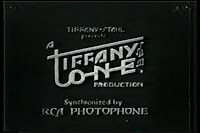 Although sharing the same title as a 1922 Mae Murray silent feature, the 1929 "Peacock Alley" is, in sum, a great deal of melodramatic hand-wringing about, when you come right down to it, an uncomfortable but hardly shattering misunderstanding. Having said that, I'll add that it's precisely the sort of absurdly tangled circumstance you'd expect to see Mae Murray (and her character) involved in, and if you can view the film (it's readily available via numerous public domain DVD distributors) try and mentally blur the line between fiction and reality and you'll be in for a dainty cinematic thrill ride of the sort where a dip of but a few inches is treated as a careening plunge --- uniquely the sort of cinematic experience that can only usually be found in product of the early sound years.
Although sharing the same title as a 1922 Mae Murray silent feature, the 1929 "Peacock Alley" is, in sum, a great deal of melodramatic hand-wringing about, when you come right down to it, an uncomfortable but hardly shattering misunderstanding. Having said that, I'll add that it's precisely the sort of absurdly tangled circumstance you'd expect to see Mae Murray (and her character) involved in, and if you can view the film (it's readily available via numerous public domain DVD distributors) try and mentally blur the line between fiction and reality and you'll be in for a dainty cinematic thrill ride of the sort where a dip of but a few inches is treated as a careening plunge --- uniquely the sort of cinematic experience that can only usually be found in product of the early sound years.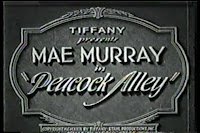 Contemporary press material assumed that the similarly titled 1922 version was still clearly a topic of conversation among 1930 audiences, and describes the plot and on-screen action neatly:
Contemporary press material assumed that the similarly titled 1922 version was still clearly a topic of conversation among 1930 audiences, and describes the plot and on-screen action neatly:"'Mae Murray in Peacock Alley.' You have heard that before, but you have never seen such a resplendent and dazzling Mae Murray, nor have you seen THIS 'Peacock Alley,' with an entirely new story, a new background and the last word in modern settings and witty, sophisticated dialogue. 'Peacock Alley' is the ne plus ultra of smart productions, recorded by RCA Photophone, and deserves your attention."
"Mae Murray never photographed more gorgeously. Her blonde mop of hair has been restrained into satiny smooth undulating waves that give her a serious air that belies the roguish witchery of her eyes and lips. Her voice is appropriate to the vividness and vitality of her, and she puts over in a charming scene at the piano, a plaintive song called 'In Dreams You Still Belong To Me.' And she dances too -- dances a splendid tango with a partner and then gives a solo comic performance interpretating a bull fighter. Her costumes are stunning, their vivid colors and the beauty of the stage setting being reproduced by Technicolor photography."
 "Carey Wilson wrote the story and dialogue for the new Tiffany All-Talking production of 'Peacock Alley' and laid the entire action in the span of twenty-four hours in a fashionable New York hotel. He properly provided the star with the role of a dancer, but also gave her some character. 'Claire Tree' does not pout - she goes after what she wants with straight-from-the-shoulder tactics."
"Carey Wilson wrote the story and dialogue for the new Tiffany All-Talking production of 'Peacock Alley' and laid the entire action in the span of twenty-four hours in a fashionable New York hotel. He properly provided the star with the role of a dancer, but also gave her some character. 'Claire Tree' does not pout - she goes after what she wants with straight-from-the-shoulder tactics.""She wants to marry - 'I'm running away from the doubt and uncertainty and problems of a woman who isn't married,' she tells Stoddard Clayton, whom she is trying to argue into including marriage with his proposition. Clayton thinks nuptial bonds old fashioned, a stupid tradition, fatal to romance! Clarie declares that any woman who says she doesn't think the marriage ceremony important is lying!'
"Neither will give in, so Claire marries a sweetheart from home - a Texan, who doesn't know the ways of New York, and accepts a detective's interpretation of Claire's actions in staying in a man's hotel suite alone with him until dawn. Forgotten is his vow of a few hours before to honor her - he can see her only as an immoral woman and leaves her. Such an abuse of the marriage oath acts as a challenge to Clayton to see if he can't do better, and the picture ends on his declaration that, when that day's ceremony has been annulled, they will make a success of marriage because they are 'different.'"
Random Thoughts:
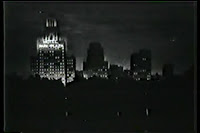
The film's title presumably refers to a long stretch of luxuriously appointed passageway within New York City's old Waldorf-Astoria hotel, (and much is made of the fact that the famed walkway was replicated at great expense in press materials for the film) and yet the film opens with an art card setting the location not as being the Waldorf, but the fictional "Park Plaza" hotel.
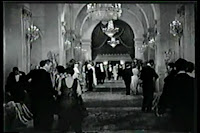 Despite that, newspaper readers were informed that "the massive sound-proof door between stages at the Tiffany Studio had to be thrown open to allow room for the massive set used to reproduce the famous hotel's peacock alley. This set is over 200 feet long, and the exquisite Oriental rugs, beautiful crystal chandeliers, valuable paintings and rare tapestries and drapes to furnish this massive set were alone valued at over $50,000.00."
Despite that, newspaper readers were informed that "the massive sound-proof door between stages at the Tiffany Studio had to be thrown open to allow room for the massive set used to reproduce the famous hotel's peacock alley. This set is over 200 feet long, and the exquisite Oriental rugs, beautiful crystal chandeliers, valuable paintings and rare tapestries and drapes to furnish this massive set were alone valued at over $50,000.00."The long tracking shot down Peacock Alley that opens the film is visually exciting --- with the camera slowly working down the passage towards a street entrance --- dodging hotel patrons and turning the lens right and left by turn, focusing on bits of business being enacted by the extras --- the naturalistic effect heightened by a soundtrack barren of everything except the murmur of voices of those the camera passes (and a symphony of noise upon the ravaged soundtrack of most circulating prints!)
 Two of the film's musical selections are heard within the first few opening moments. Over the titles, (following the grandiose Tiffany-Tone logo theme) we hear "In Dreams You Still Belong To Me" (for the first and last time, as Murray's later vocal at the piano is jarringly excised from the print I viewed.) Shortly thereafter, in a hotel club setting, "She's Everybody's Gal" is played by the on-set orchestra and vocalized by The Biltmore Trio (right) who also provide the opening title off-screen vocals. Curiously, the participation of this popular period vocal team in "Peacock Alley" appears to have been wholly overlooked by those who keep such lists. Nothing to be ashamed of here, as they acquit themselves adequately in the two Abner Silver composed tunes.
Two of the film's musical selections are heard within the first few opening moments. Over the titles, (following the grandiose Tiffany-Tone logo theme) we hear "In Dreams You Still Belong To Me" (for the first and last time, as Murray's later vocal at the piano is jarringly excised from the print I viewed.) Shortly thereafter, in a hotel club setting, "She's Everybody's Gal" is played by the on-set orchestra and vocalized by The Biltmore Trio (right) who also provide the opening title off-screen vocals. Curiously, the participation of this popular period vocal team in "Peacock Alley" appears to have been wholly overlooked by those who keep such lists. Nothing to be ashamed of here, as they acquit themselves adequately in the two Abner Silver composed tunes.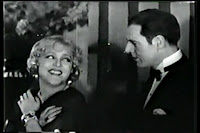 "Peacock Alley" (1929) - Biltmore Trio & Orchestra
"Peacock Alley" (1929) - Biltmore Trio & OrchestraOpening Titles, "She's Everybody's Gal" and Closing Titles
"Peacock Alley" (1929) - Dialogue Excerpt #1
Here, the hotel house detective positively ruins Murray's first day of marriage by accusing her of being a... well, a hotel whore in front of her new husband. (No charge for the soundtrack noise!)
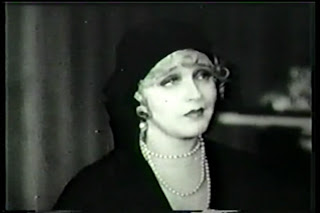
In our last audio selection from "Peacock Alley," Mae's luck has turned from bad to worse. While visiting her ex-boyfriend in an attempt to have him explain the whole mess to her new husband, said new husband arrives on the scene and the ex-boyfriend amuses himself by refusing to admit that Mae's overtures were anything but what they appear to be. Exit new husband, while Mae casts eyes heavenward in weary, weary misunderstood disbelief.
"Peacock Alley" (1929) Dialogue Excerpt #2
 Sadly, I've nothing of the film's Technicolor finale to offer aside from my own faint memory of seeing an abbreviated version of the reel many moons ago, and the first hand account of a friend who was treated to a screening of the entire Technicolor reel at the British Film Institute a few years ago. What's worth mentioning however is that when seen intact, and as evidenced by press material of the day, Murray's infamous bullfight dance sequence was intended as a comic parody. There's been more than once instance where footage has been lifted from the reel to illustrate just how bad a film it is, or just how bad an actress Mae Murray was, or just how bad early musicals were in general. Misleading and destructive, and precisely the sort of "anything goes" treatment that films of the early sound period have been treated to for decades.
Sadly, I've nothing of the film's Technicolor finale to offer aside from my own faint memory of seeing an abbreviated version of the reel many moons ago, and the first hand account of a friend who was treated to a screening of the entire Technicolor reel at the British Film Institute a few years ago. What's worth mentioning however is that when seen intact, and as evidenced by press material of the day, Murray's infamous bullfight dance sequence was intended as a comic parody. There's been more than once instance where footage has been lifted from the reel to illustrate just how bad a film it is, or just how bad an actress Mae Murray was, or just how bad early musicals were in general. Misleading and destructive, and precisely the sort of "anything goes" treatment that films of the early sound period have been treated to for decades."Peacock Alley" is uneven, technically primitive, and probably a misfire from the get-go. But, it is what it is --- a time capsule moment in cinema history and a surviving record of an actress already well along in her headlong plummet from silent film stardom. Surely it doesn't require further sensationalistic embellishments --- especially imagined ones!
 No matter that Mae Murray's realm is primarily considered that of the silent screen, her name and face can't easily be thought of without musical accompaniment. To be sure, the melody that would mark the height of her career and also her death (it would be played at her funeral) was "The Merry Widow Waltz." Here, from 1926 is a simple arrangement rich in period charm:
No matter that Mae Murray's realm is primarily considered that of the silent screen, her name and face can't easily be thought of without musical accompaniment. To be sure, the melody that would mark the height of her career and also her death (it would be played at her funeral) was "The Merry Widow Waltz." Here, from 1926 is a simple arrangement rich in period charm:"The Merry Widow Waltz" (1926) The Utopia Salon Orchestra
While there's no clear evidence that the 1922 melody "Suez" was ever associated with the actress, I find the tune's use (and performance) by the Mont Alto Motion Picture Orchestra for the score of 1919's "Delicious Little Devil" (included as an "extra" feature on the Milestone DVD release of the turgid 1922 Gloria Swanson & Rudolph Valentino feature "Beyond the Rocks" when it can be considered just as entertaining if not as an "important" film as the one it accompanies.)
Utilized to score Mae Murray's incredible "peacock dance" in the film --- it's a perfect union of image and music, with one complimenting the other rather than doing battle, which is so often the case with newly scored silent films. Although the sequence is poorly photographed and edited (Murray's queer gyrations and postures seem an almost nightmarish jumble at times) the insane pseudo-oriental music ("a fox trot romance") rescues the moment magnificently.

"Suez" (1922)
"In old Suez, under mystic sky,
near the old Red Sea, where ships go by;
There where the palm trees sway,
Your lips and eyes plead with me to stay -- in...
Su-ez, wond'rous Su-ez,
Where I was captured with your love sigh,
All day, and through the night,
to be with you I cry!
When you enfold me in your sweet loving arms,
I feel the thrill of all your charms dear,
Su-ez, wond'rous Su-ez,
I lost my heart to you!"
"Suez" - Mont Alto Motion Picture Orchestra
"Suez" (1922) Clyde Doerr & His Orchestra
 And here is Mr. Clyde Doerr himself, circa 1920, looking eerily much as you might expect him to look after hearing his orchestra's strident arrangement of "Suez" which still managed to work in a tinge of playfulness in the form of a slide whistle. Clyde Doerr pretends to light a cigarette on an unlit decorative candle --- neatly wrapped holiday gifts (poinsettia blooms mark the season) sit on the table (are they from or to him?) and the man himself is the Arrow Collar ad personified. Crisp and clean from his razor cut hair to his pince-nez and down to his manicured fingers, he's quite a fellow, don't you think?
And here is Mr. Clyde Doerr himself, circa 1920, looking eerily much as you might expect him to look after hearing his orchestra's strident arrangement of "Suez" which still managed to work in a tinge of playfulness in the form of a slide whistle. Clyde Doerr pretends to light a cigarette on an unlit decorative candle --- neatly wrapped holiday gifts (poinsettia blooms mark the season) sit on the table (are they from or to him?) and the man himself is the Arrow Collar ad personified. Crisp and clean from his razor cut hair to his pince-nez and down to his manicured fingers, he's quite a fellow, don't you think?Now, if only we could discover what's in those packages. Handkerchiefs? Sensible woolen underwear? We'll never know... and I suspect he wouldn't appreciate our curiosity either.
To round out this post, the second and last for September of 2007, we have a bit of music and then some visual oddities.
 "Chirpy" aptly describes "Swanee Bluebird," a 1922 melody performed by the Benson Orchestra of Chicago ("under the direction of Roy Bargy" I feel compelled to add) and if the title seems a bit off-putting, give it a try. It's exceptionally lively, it doesn't sound like four dozen other tunes of the period, and the addition of "whistling variations by Master Billee Osborn" elevates it from the typical to the unique.
"Chirpy" aptly describes "Swanee Bluebird," a 1922 melody performed by the Benson Orchestra of Chicago ("under the direction of Roy Bargy" I feel compelled to add) and if the title seems a bit off-putting, give it a try. It's exceptionally lively, it doesn't sound like four dozen other tunes of the period, and the addition of "whistling variations by Master Billee Osborn" elevates it from the typical to the unique."Swanee Bluebird" (1922)
 Flip this 78rpm disc over, and we're with Victor's "All Star Trio," pictured right, which consisted of saxophonist Wheeler Wadsworth, xylophonist George Hamilton Green and, lo and behold, pianist Victor Arden --- soon to rise to greater success as part of a team of dual pianists. (See previous post for further information on Arden & Ohman.)
Flip this 78rpm disc over, and we're with Victor's "All Star Trio," pictured right, which consisted of saxophonist Wheeler Wadsworth, xylophonist George Hamilton Green and, lo and behold, pianist Victor Arden --- soon to rise to greater success as part of a team of dual pianists. (See previous post for further information on Arden & Ohman.)Here, the Trio performs "Just Because You're You," and it's a pretty enough tune as far as these things go. If "Swanee Bluebird" pleased you, so will:
"Just Because You're You" (1922) All Star Trio
As a follow up to this blog's previous post which highlighted the 1919 melody"The Vamp," it's nice to learn that the melody was still being trotted out as late as 1932 by Phil Harris & His Orchestra, and as you'll hear, sounds none the worse for its advancing age.
"The Vamp" (1932) Phil Harris & His Orchestra
To close --- before entering the gallery that lines the passageway leading to the exit --- here's a video montage of curious fragments of Technicolor footage, which looks to be circa 1928 or so, that would seem to have been originally produced with the intention of advertising seasonal fashions at an unknown retail establishment while also promoting various starlets of the day. Alice White and Marion Nixon are easily spotted --- but the others? Perhaps you, the reader, can identify the others.
Until Next Time!
###
###
Late in the Season but: "Beach Babies"
A 1929 Pathe Short Comedy
A 1929 Pathe Short Comedy

Last seen in the vicinity of Appleton, Wisconsin
25 October 1929
25 October 1929

Lobby Card for "The Haunted House" (1928)
Thelma Todd and Montague Love
(You can learn more about this lost film in this earlier post)

Selections from the Mae Murray Scrapbook of Woes
Thelma Todd and Montague Love
(You can learn more about this lost film in this earlier post)

Selections from the Mae Murray Scrapbook of Woes
21 May 1930

14 June 1930

16 April 1931

8 July 1931

2 August 1931

6 August 1931

17 August 1931
For now at least, a happy ending...
17 October 1931

Vitaphone Talk #3
Coshocton, Ohio, 28 October 1927
Coshocton, Ohio, 28 October 1927

































